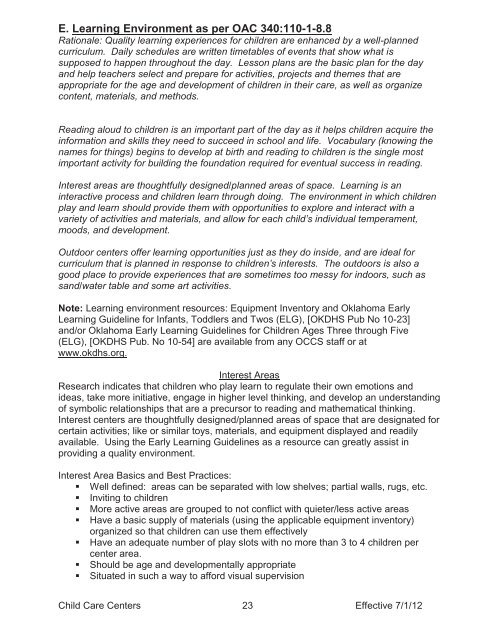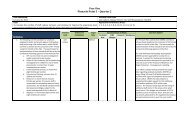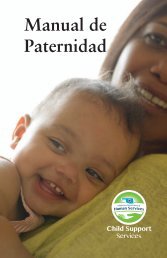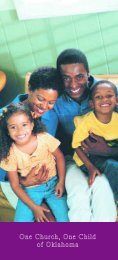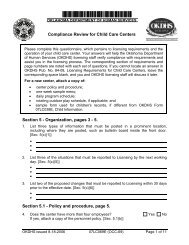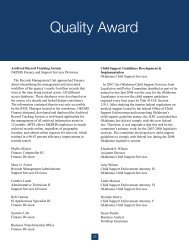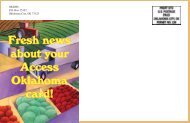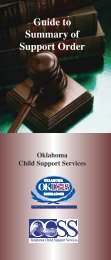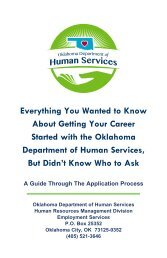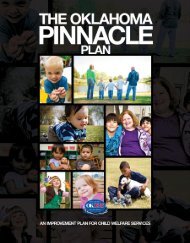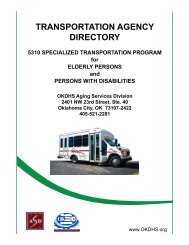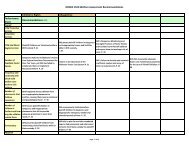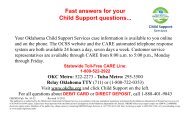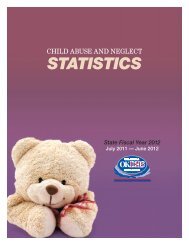Reaching for the Stars - Oklahoma Department of Human Services
Reaching for the Stars - Oklahoma Department of Human Services
Reaching for the Stars - Oklahoma Department of Human Services
You also want an ePaper? Increase the reach of your titles
YUMPU automatically turns print PDFs into web optimized ePapers that Google loves.
E. Learning Environment as per OAC 340:110-1-8.8<br />
Rationale: Quality learning experiences <strong>for</strong> children are enhanced by a well-planned<br />
curriculum. Daily schedules are written timetables <strong>of</strong> events that show what is<br />
supposed to happen throughout <strong>the</strong> day. Lesson plans are <strong>the</strong> basic plan <strong>for</strong> <strong>the</strong> day<br />
and help teachers select and prepare <strong>for</strong> activities, projects and <strong>the</strong>mes that are<br />
appropriate <strong>for</strong> <strong>the</strong> age and development <strong>of</strong> children in <strong>the</strong>ir care, as well as organize<br />
content, materials, and methods.<br />
Reading aloud to children is an important part <strong>of</strong> <strong>the</strong> day as it helps children acquire <strong>the</strong><br />
in<strong>for</strong>mation and skills <strong>the</strong>y need to succeed in school and life. Vocabulary (knowing <strong>the</strong><br />
names <strong>for</strong> things) begins to develop at birth and reading to children is <strong>the</strong> single most<br />
important activity <strong>for</strong> building <strong>the</strong> foundation required <strong>for</strong> eventual success in reading.<br />
Interest areas are thoughtfully designed/planned areas <strong>of</strong> space. Learning is an<br />
interactive process and children learn through doing. The environment in which children<br />
play and learn should provide <strong>the</strong>m with opportunities to explore and interact with a<br />
variety <strong>of</strong> activities and materials, and allow <strong>for</strong> each child’s individual temperament,<br />
moods, and development.<br />
Outdoor centers <strong>of</strong>fer learning opportunities just as <strong>the</strong>y do inside, and are ideal <strong>for</strong><br />
curriculum that is planned in response to children’s interests. The outdoors is also a<br />
good place to provide experiences that are sometimes too messy <strong>for</strong> indoors, such as<br />
sand/water table and some art activities.<br />
Note: Learning environment resources: Equipment Inventory and <strong>Oklahoma</strong> Early<br />
Learning Guideline <strong>for</strong> Infants, Toddlers and Twos (ELG), [OKDHS Pub No 10-23]<br />
and/or <strong>Oklahoma</strong> Early Learning Guidelines <strong>for</strong> Children Ages Three through Five<br />
(ELG), [OKDHS Pub. No 10-54] are available from any OCCS staff or at<br />
www.okdhs.org.<br />
Interest Areas<br />
Research indicates that children who play learn to regulate <strong>the</strong>ir own emotions and<br />
ideas, take more initiative, engage in higher level thinking, and develop an understanding<br />
<strong>of</strong> symbolic relationships that are a precursor to reading and ma<strong>the</strong>matical thinking.<br />
Interest centers are thoughtfully designed/planned areas <strong>of</strong> space that are designated <strong>for</strong><br />
certain activities; like or similar toys, materials, and equipment displayed and readily<br />
available. Using <strong>the</strong> Early Learning Guidelines as a resource can greatly assist in<br />
providing a quality environment.<br />
Interest Area Basics and Best Practices:<br />
• Well defined: areas can be separated with low shelves; partial walls, rugs, etc.<br />
• Inviting to children<br />
• More active areas are grouped to not conflict with quieter/less active areas<br />
• Have a basic supply <strong>of</strong> materials (using <strong>the</strong> applicable equipment inventory)<br />
organized so that children can use <strong>the</strong>m effectively<br />
• Have an adequate number <strong>of</strong> play slots with no more than 3 to 4 children per<br />
center area.<br />
• Should be age and developmentally appropriate<br />
• Situated in such a way to af<strong>for</strong>d visual supervision<br />
Child Care Centers 23 Effective 7/1/12


